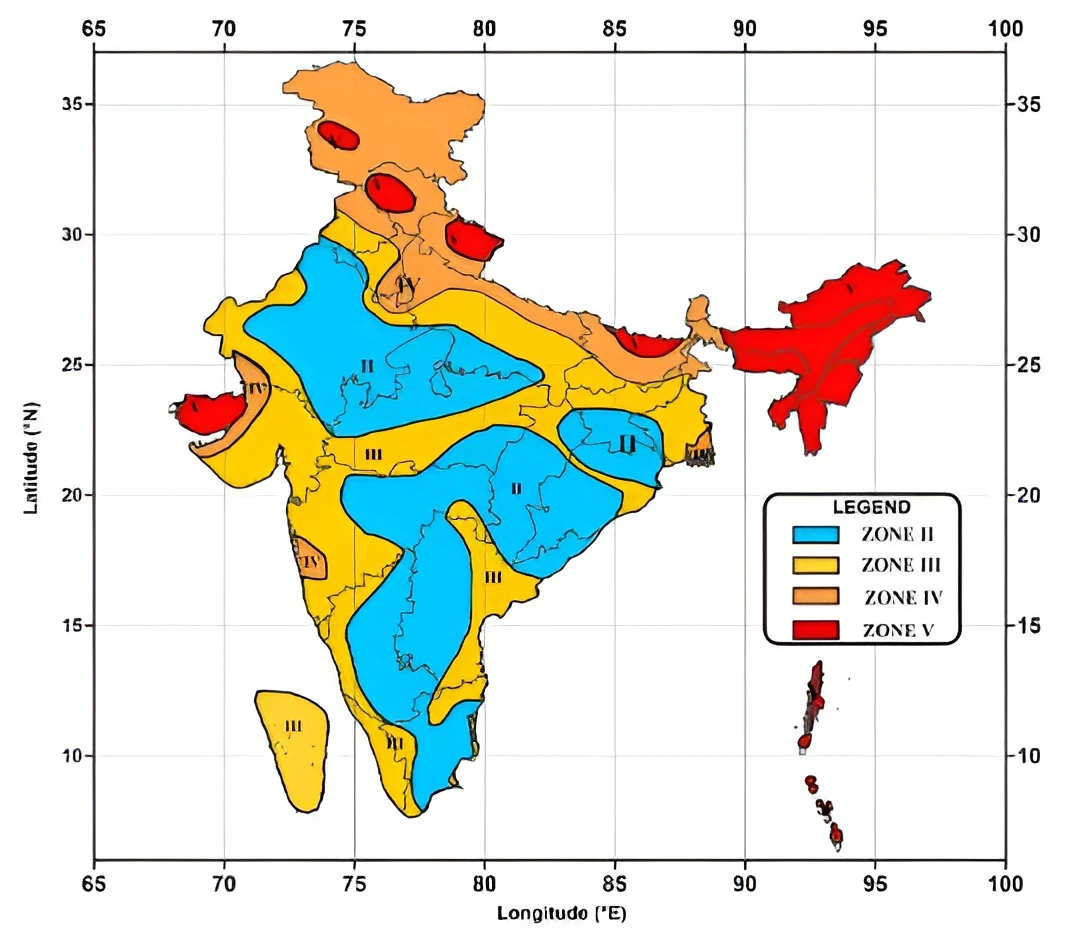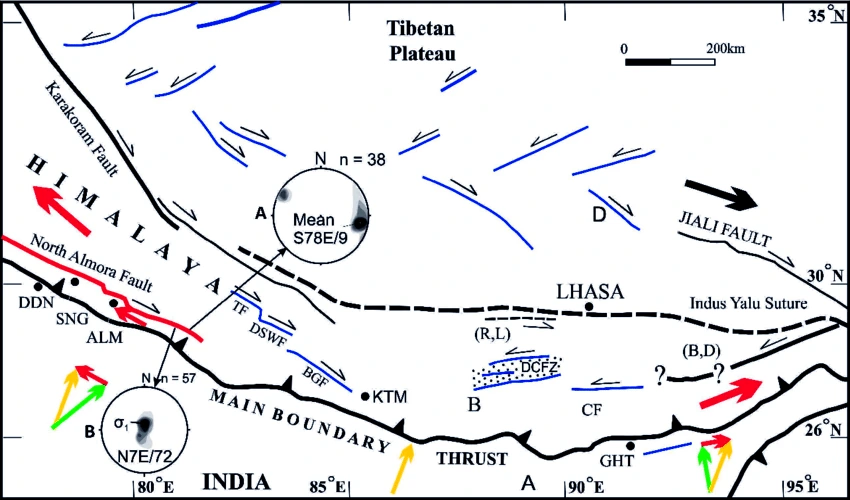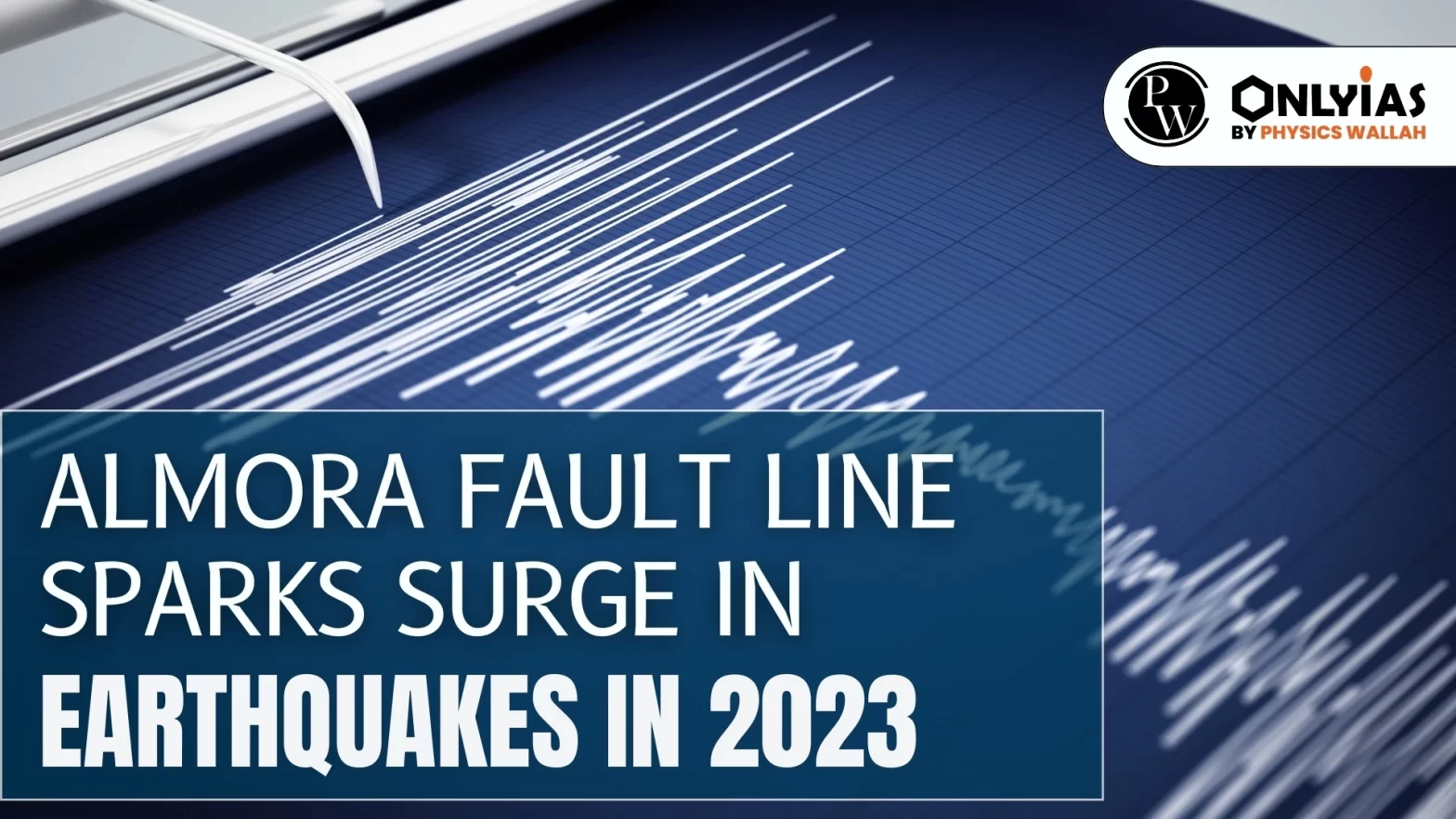Context: This article is based on the news “Have earthquakes really increased in India due to activation of Almora Fault?” which was published in the Down to Earth. As per recent news report, there has been an increase in the number of earthquakes between January to November, 2023 compared to the last three years.
Almora Fault Line Behind High Seismicity in 2023
- Earthquakes linked to Almora Fault Line: The rise in earthquake activity in 2023 has been linked primarily to the activation of the Almora fault in Western Nepal.
- The activation led to major earthquakes on January 24, 2023 (magnitude 5.8), October 3, 2023 (magnitude 6.2) and November 3, 2023 (magnitude 6.4).
- However, the geologists have negated the view that the rise in earthquake frequency is on account of the active Almora fault.
About Almora Fault Line: The Almora Fault line is a high angle west-northwest-east-southeast to northwest-southeast trending tectonic plane.
- It separates the Garhwal group of inner lesser Himalayas in the north from Jaunsar and Dudhatoli Groups of outer lesser Himalayas in the south.
What is an Active Fault?
- Faults are commonly considered to be active if there has been movement observed or evidence of seismic activity during the last 10,000 years. .
- None of the faults in the Himalayas — Main Boundary Thrust, North Almora Thrust or South Almora Thrust are active.
|
Views of Geologists Regarding Almora Fault Line Becoming Active
- Mainshock Leading to Aftershock: Tectonic collision is the reason behind earthquakes in the Himalayan region and smaller earthquakes/aftershocks are mostly followed by severe earthquakes.
- In 2023, there were two major earthquakes, one in January and another in November, leading to an overall increase in seismic activity this year.
- MBT Behind Earthquakes: As per the Geologists, the earthquakes in the Himalayan region are attributed to a fault known as the Main Himalayan Thrust (MBT).
- Both major earthquakes in 2023 occurred on the MBT and have been incorrectly attributed to the Almora Fault.
| Thrust: A thrust fault is a break in the Earth’s crust.
Thrusts in Uttarakhand:
- There are two thrusts in Kumaon, Uttarakhand: South Almora Thrust and North Almora Thrust.
- This Almora Fault extends to western Nepal.
Internal Structure of Earth
- Crust: The top layer of Earth is known as the crust, which is made of layered rocks.
- Mantle: The next layer is the mantle, which is made of rocks in semi-molten form.
- Seismicity in mantle: The pressure in the mantle is very high and the seismicity within the layer causes movements in the upper crust.
- The energy sometimes reaches the boundary and collides with the edge of another tectonic plate.
|
-
- MBT is situated approximately 15 to 20 kilometers below the mountain range.
- No Active fault: None of the faults in the Himalayas i.e., Main Boundary Thrust, North Almora Thrust or South Almora Thrust are active.
- Almora Thrust: The government has incorrectly mapped the recent earthquakes in the North or South Almora Thrust.
- The Almora Thrust is not deep and does not reach the mantle and thus, the possibility of an earthquake is negligible.
What is an Earthquake?
- It is the violent shaking of the ground and everything over it. It results from the release of accumulated stress of the moving lithospheric or crustal plates.
Earthquake Risk in India
- As per the current seismic zone map of the country, over 59 per cent of India’s land area is under threat of moderate to severe seismic hazard.
- The entire Himalayan belt is considered prone to great earthquakes of magnitude exceeding 8.0.
- Scientific publications have warned of the likelihood of the occurrence of very severe earthquakes in the Himalayan region, which could adversely affect the lives of several million people in India.
Seismic Zonation of India
- Seismic Zonation map of the country (state wise) given by the Bureau of Indian Standards (BIS) has categorized India into seismic zones (Zone II to Zone V).
- Almora in Uttarakhand is located in Seismic Zone IV.

Why is the Himalaya region Prone to Earthquake?
- Tectonic Movements: The Himalayas is a tectonically unstable region as it is the convergence zone of the Indian and Eurasian plates.
- The two plates are constantly pushing against each other and over time, stress accumulates and periodically releases as earthquakes, as was the case with the recent Nepal earthquake.
Reasons for Current Increase in Earthquakes
- The increase in earthquake risk is due to an increase in developmental activities driven by urbanization, economic development and the globalization of India’s economy.
- The increase in use of high-technology equipment and tools in manufacturing and service industries has made them susceptible to disruption due to relatively moderate ground shaking.
|
- Mountain Building Process: The mountain building process is still going on because the Indian plate is still moving towards the Eurasian plate.
- The Indian plate is pushing the Asian plate northward at the rate of about 2 cm per year. This means that in every 100 years India moves 200 cm north against the Asian plate.
- Fault Lines: The existence of various fault lines makes it susceptible to earthquakes.
- The stress accumulation along these faults leads to seismic activities when released.
- Non-Uniform Structure of Himalayas: The Himalayas are not uniform and assume different physical and mechanical properties in different directions.
- This resulted in significantly large earthquake events in the Himalayas.

- Instability of region: Due to the ongoing tectonic activity in Nepal since 2015, the entire region has become increasingly unstable.
- Tectonic Plates: The earth’s crust is divided into seven major plates, that are about 50 miles thick, which move slowly and continuously over the earth’s interior and several minor plates.
- Tectonic Collision: Earthquakes are tectonic in origin; that is the moving plates are responsible for the occurrence of violent shakes.
|
-
- Moreover, certain areas experience aftershocks due to past earthquakes.
- Human Activities: Activities such as mining, reservoir-induced seismicity from filling large reservoirs, and geothermal energy extraction can also induce earthquakes, though these are typically of lower magnitudes.
Also Read: Interconnected Disaster Risks Report 2023
Measures taken towards Earthquake prevention in India
- Seismic Zoning Map of India: The Bureau of Indian Standards (BIS) published the Seismic Zoning Map of India, ranging from Zone II to V.
- It offers guidelines for implementing the essential engineering codes and practices to construct earthquake-resistant buildings.
- National Centre for Seismology (NCS): NCS under Ministry of Earth Sciences is the nodal agency of Government of India (GoI), for monitoring earthquakes in and around the country.
- NCS maintains a National Seismological Network (NSN) consisting of 115 observatories for disseminating earthquake information to the concerned central and state disaster authorities.
- Seismic Microzonation of cities: This is to be done in cities having populations of 5 Lakh and above.
- The purpose is to generate inputs for constructing earthquake risk resilient buildings / structures to reduce and mitigate the impacts of earthquakes.
- National Disaster Management Authority (NDMA): It is engaged with conducting regular awareness campaigns every year to sensitize programs on prevention and preparedness for building safety from earthquakes.
Must Read: Disaster Management In India
Way Forward/Six Pillars of Earthquake Management:
- Ensure the incorporation of earthquake resistant design features for the construction of new structures.
- Facilitate selective strengthening and seismic retrofitting of existing priority and lifeline structures in earthquake-prone areas.
- Improve the compliance regime through appropriate regulation and enforcement.
- Improve the awareness and preparedness of all stakeholders.
- Introduce appropriate capacity development interventions for effective earthquake management (including education, training, R&D, and documentation).
- Strengthen the emergency response capability in earthquake-prone areas.
Conclusion:
The surge in earthquakes in 2023 in India is incorrectly attributed to the Almora Fault line, as geologists point to the Main Himalayan Thrust (MBT) as the actual cause, highlighting the ongoing seismic risk in the Himalayan region.
![]() 13 Dec 2023
13 Dec 2023


